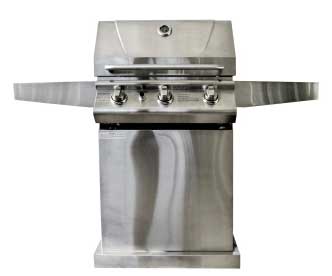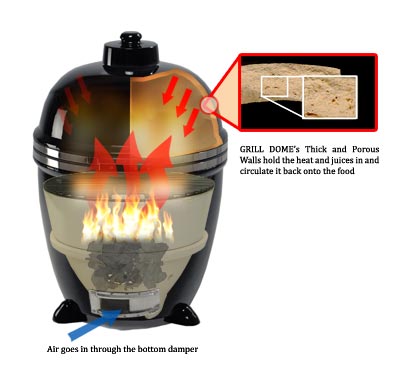1) First, how do metal grills work?
Nearly 8 out of 10 households own an outdoor barbecue grill or smoker in the US. Over the years, consumers have widely adopted gas or charcoal metal grills, as they are the most available product on the market. While metal grills come in many different shapes and sizes and designs, they all essentially work the same. Metals are highly conductive materials that dissipate a lot of energy which has to be continually replaced. This appetite for energy can not only be inefficient but can also dry out foods.
BTU’s -
A BTU (British Thermo Unit) is the quantity of heat required to raise the temperature of one pound of water from 60° F to 61°F at a constant pressure. It’s usually stated as a number for the whole grill and a per burner number
One of the core features of a gas grill is the amount of BTU’s the burner generates. This metric is important for a metal grill since it helps describe how much energy can be created to replace the energy being displaced. Although this metric is important for metal grills, BTU’s don’t define the quality of a ceramic grill in a similar fashion as we will further explain later. Gas grills can range from 5,000 BTU's to a high of 200,000. Most two-burner grills weigh in at about 40,000 BTU's.
 |
2) How moisture and heat is lost in a metal grill
Metal grills are usually constructed from stainless steel, cast iron, aluminum or porcelain enamel coated steel. During the cooking process, all these metals dissipate large amounts of heat through the surface of the grill. This heat is continually replaced by drawing more air into the unit. This is why metal grills require burners that can generate high number of BTU's, since more heat must be generated to replace the heat being lost. As more air is drawn into the unit, the air is burned by the burner, and released back out. The extra draft carries out much of the moisture and juices with it, and the longer you cook on a metal grill, the more risk you run of drying out your foods. Also, maintaining a precise heat range in a metal grill can prove challenging since there is a high variation in the heat loss during the cooking process, and the temperature of the grill can fluctuate significantly every time the grill is opened. |
SUMMARY: A metal grill has the following disadvantages over a ceramic grill -
1) |
Metal grills burn fuel inefficiently and require sophisticated burners to generate high BTU’s to continually replace the energy radiated through the metal walls |
2) |
A metal grill has to draw in much more air to burn as the heat is being dissipated, which will dry out the food as the draft out carries moisture and juices out with it |
3) Now, how does Grill Dome work?
Grill Dome ceramic grills have been developed to eliminate the inefficiency of metal grills and ensure your food remains juicy and tasty. Properly designed ceramics can lock in the juices of the meat and circulate them back onto the food, and can significantly reduce heat loss and the need to burn fuel inefficiently to replace the heat.
Grill Dome uses a three part solution for the issues found in metal grills – a premium blend of ceramics, efficient airflow design, and precise and heavy-duty construction.

Click to enlarge
1. TERAPEX Ceramics - First and foremost it is important to note that not all ceramics are created equal. Terapex Ceramics are the latest brand of ceramic technology from GRILL DOME. As you might expect, the most important quality of any ceramic grill is the recipe or blend of ceramics used in the grill. Furthermore, the two most important qualities for ceramics in a ceramic cooker are the porosity and density of the ceramics. When comparing ceramic grills, the blend of ceramics is an important attribute to consider.
 |
Porous – In order to effectively lock in the juices, the ceramics must be porous and be able to absorb the moisture released during cooking in order to circulate the juices back on to the foods. The porosity of ceramics is analogous to household paper towel soaking up water – the more the ceramics can soak up, the more moisture is available to radiate back onto the foods during the cooking.
|
 |
Density – There is a simple relationship between density and conduction. The denser a material the more conductive it is. Ceramics that are not dense can be extremely effective in capturing the heat generated by fire and storing that energy in the walls and circulating it back onto the food. This heat is preserved instead of being dissipated as in metal grills and therefore requires much less fuel to cook the same amount of food. |
2. Efficient Airflow Design
Grill Dome features a time tested and unique airflow design. The grill has a two damper system – one at the bottom that draws in the air, and one on the top that regulates the smoke flavor desired. Air is brought in from the bottom damper and circulated to the charcoal where the fire is burning and the heat and moisture is absorbed by the ceramics, and then the remaining air leaves the unit via the top damper. This type of draft creates a "chimney effect" in the grill, and it is specifically this trait that enables you to start your grill in about 10 minutes – without lighter fluid! During the cooking process, the dampers can be adjusted to control the temperature of the grill and the amount of smoke flavor desired in the food.
3. Heavy-Duty Construction
Grill Dome walls are THICK! - almost twice as thick as our competitors. The thicker walls mean we are able to hold even more heat in than other ceramic grills on the market. The unit is constructed not only with heavy duty ceramics that will last a lifetime, but also with heavy-duty hardware. The lid and base are also machined during our manufacturing process to ensure a tight fit and ensure proper air flow is maintained.
|


